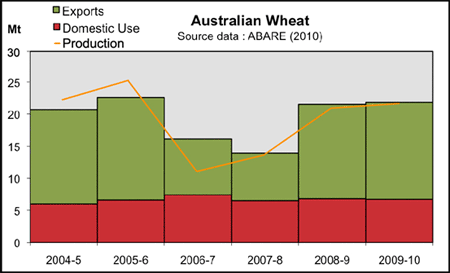The debate on Australia’s future population size has taken a welcome leap forward in 2010. Much attention is focused on the Treasury estimate of 36 million Australian residents by 2050 (PDF 170KB). Most of the reasons given for why this is not a desirable outcome centre around quality-of-life issues and whether our natural environment can withstand the impact of so many Australians living relatively wealthy lifestyles requiring high levels of consumption. However, one question that is hardly ever raised is whether we can, in fact, feed 36 million people.
Historically, being a net exporter of food, we have rejected the idea that Australia might one day lack the ability to sustain its human residents. But what do the numbers say? And will our capacity to produce food in the future be the same as today? These are important questions for anyone with a stake in Australia’s future - in other words all current and future parents.
So what do we currently eat? Let’s divide up our diet into fruit and vegetables, grains and pulses, and meat. (Dairy products and fish will be mentioned later.) The most important part of these three categories is grains and pulses - not only because they form our staples (e.g. breakfast cereals, pasta, bread and rice etc.) but because, as you will see, a very large proportion go into making meat.
Advertisement
However, let’s start with fruit and vegetables. This is a large and very diverse category so the simplest way to view production and consumption is in monetary terms. From the document “Signposts for Australian Agriculture” (PDF 642KB) (and a shorter summary (PDF 373KB)) produced by the National Land and Water Resources Audit of the federal government we learn that: “Australia became a net importer of fruit in 2006-07 and has been a net importer of vegetables since 2002-03.”
They base this on “gross value of production” data from a report by ABARE, the Australian Bureau of Agricultural and Resource Economics (see page 7 of the “Signposts” report above).
It is also worthwhile noting the comment that: “Since 2000-01, the main constraint on the industry’s productive capacity has been climate variability and the impact of two severe droughts in quick succession on production and farm profitability. Low water availability from natural rainfall and restricted irrigation water allocations have been key production limiting factors.”
This suggests that climate change and finite resources (e.g. water) are already impacting on our food production. This is also indicated by another comment: “There have been rapid rises in input costs, particularly fertiliser and fuel.”
So, in terms of Australia’s fruit and vegetable production, we are not even supplying all of the needs of our current population. Supplies of fruit and veg for a growing Australian population will be dependent upon the willingness and ability of other nations to sell us this food.
Now to the grain category. The “Australian Crop Report” (PDF 854KB) of February 2010 compiled by ABARE gives historical and current information on Australian grain production, consumption and exports. Tables 5 and 6 in this document show the numbers for “Australian supply and disposal of wheat, oilseeds and pulses” (consumed by humans and animals) and “Australian supply and disposal of coarse grains” (predominantly consumed by animals) respectively for the financial years 2004-5 to 2009-10 (predicted).
Advertisement
For wheat, in an average year and under current conditions (fuel, fertiliser, climate), Australia can produce about 22 million tonnes (Mt) although drought can slash this by over half (see 2006-7 and 2007-8):

Note that in the drought years domestic use and exports for wheat were similar, i.e. we used half or more of what we produced. A bit over one third of our domestic use of wheat is for direct human consumption. The rest is used to feed animals and to provide seed for the next year’s crop.
Discuss in our Forums
See what other readers are saying about this article!
Click here to read & post comments.
16 posts so far.